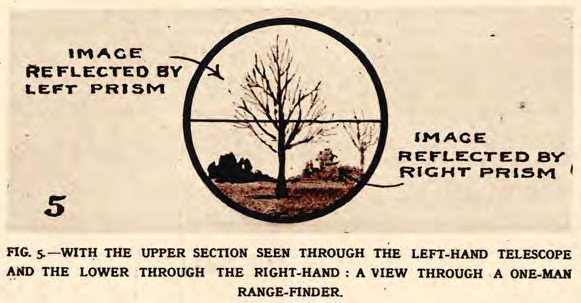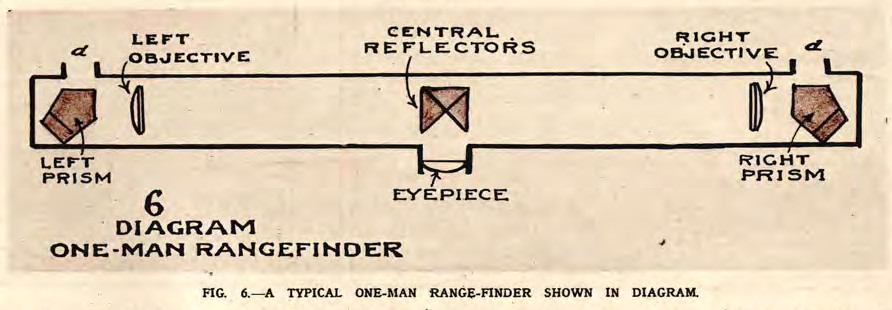Topic: Militaria

How It Works: The Rangefinder (1915)
The Illustrated War News, 31 March 1915
The Range-finder, as the name implies, is an instrument for ascertaining the distance to any visible point on the landscape from the position occupied by the observer, or operator, who is known as the Range-Taker. Range-finders are of two types: the double-observer type, such as the Mekometer, or Telemeter, used in our own service; and the "one-man" type. In both cases the distance to the object (or range) is found by triangulation, the angles being taken from the ends of a known base…a very short base of about three feet in the case of the one-man range-finder, and a normal base of fifty yards for the Mekometer artillery instrument, and twenty-five yards with the infantry instrument.
Fig. I on the opposite page illustrates the Mekometer instrument in use, and shows clearly the base, which is the known length of cord stretched between the two instruments, held by the two observers. The man, marked A, with the reading instrument sights an object (in this case, a church) of which the range is required. The second man, marked B, advances until he can, through his right-angling instrument, see both the same object and the sighting-vane on A's instrument. When these two coincide, he shouts "On," and A, by turning the range-drum on his instrument until he also makes the reflection of B's sighting-vane coincide with the object seen in the instrument, is then able to read the range off the range-drum in yards. This instrument was employed at the time of the South African War, but owing to its having a very long base (25-50 yards), and requiring two men to operate it, was found extremely difficult to use because of the lack of cover. In one-man range-finders the base is a bar, or frame, of short length, with a telescope mounted at each end, and having an eye-piece in the middle into which the rays are reflected. With this instrument, measuring only 37 inches long by 3 inches in diameter, and weighing 5 ½ lb., one man is able rapidly and accurately to take ranges of objects up, to 20,000 yards distant. In taking the range the operator directs the telescopes of the instrument on to a clearly defined object, and by turning the range-drum (Figs. 3 and 2) the right-hand telescope is inclined inwards until the two images seen in the central eye-piece coincide. The range given on the drum can then be read.

A typical one-man range-finder is illustrated, diagrammatically, in Fig. 6. It shows the two telescopes already mentioned running at right-angles to the single eye-piece fixed in the centre of the range-finder tube. The rays from the distant object entering the end apertures (a a) of the range-finder base, are received by the left and right prisms and transmitted through the left and right objectives towards the central reflectors, which reflect them outwards through the eye piece. The observer looking into the eyepiece will see the field of view divided by a thin "dividing line." Anything seen above this horizontal line is formed by the left-hand telescope, and that seen below the dividing-line by the right-hand telescope (Figs. 4 and 5). The view will be similar to the images shown in Fig. 4. before coincidence. By turning a drum, these images can be brought into coincidence, and the correct range can be read from the range-drum.



